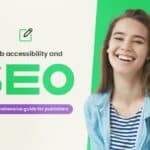Web Accessibility and SEO: A Comprehensive Guide for Publishers
Unleash the Power: Elevate Your Web Presence with Accessible Content and SEO Mastery

In the digital age, finding content is just the first step. What truly matters is the quality of the online experience and the accessibility it offers to all users. Unfortunately, many websites fall short in providing access to individuals with disabilities. People with visual impairments, motor difficulties, or hearing challenges deserve equal access to the web’s wealth of information. In this guide, we explore the intersection of web accessibility and SEO, providing publishers with essential insights to enhance their online presence and impact.
The Significance of Web Accessibility
Picture this: you stumble upon a promising webpage, but the fonts are too small to read or the images lack meaningful descriptions. Such barriers hinder not only individuals with disabilities but also erode the overall user experience. Our blog warmly welcomes partners of Grumft, and if you’re not yet acquainted with us, this content aims to inspire your interest in our exclusive programmatic solutions tailored for publishers, app developers, and advertisers. This article uncovers the world of web accessibility and highlights its symbiotic relationship with SEO.
Decoding Web Accessibility
Web accessibility encapsulates the ease with which individuals with disabilities can access content on websites and applications. Consider these scenarios:
- Total Visual Impairment: Websites must be structured to be interpretable by programs that read text aloud and convey visual images.
- Partial Visual Impairment or Color Blindness: Web pages need to offer adjustable fonts and utilize contrasting colors for readability.
- Total or Partial Hearing Impairment: Audio content requires text-based alternatives or the inclusion of video sign language.
- Physical Disabilities: Just as visually impaired users require specialized interfaces, those with physical limitations can navigate the web using voice commands or eye-tracking technology.
- Cognitive and Neurological Disabilities: Texts must be well-structured with titles, subtitles, and lists. Line lengths should be limited to 70-80 characters, whitespace should be employed generously, and color schemes, fonts, and element placements must be consistent. Furthermore, keyboard support and multimedia alternatives are crucial for individuals with cognitive, learning, or neurological disabilities.
The Nexus of Accessibility and SEO
At first glance, web accessibility and Search Engine Optimization (SEO) might seem unrelated. However, they share a common goal: making content discoverable and engaging. Just as SEO involves optimizing content for search engine bots, web accessibility ensures that content can be understood and navigated by users with disabilities.
Unveiling the Principles of Web Accessibility
The World Wide Web Consortium (W3C) outlines four core principles that underpin web accessibility:
- Perceivable: Content should be presented in a way that users can access it through various senses.
- Operable: Users should have control over all aspects of content interaction, using methods like keyboard input and assistive technologies.
- Understandable: The format of content should make sense to users, including language, instructions, and usability.
- Robust: Web content should remain accessible across various devices and technologies, ensuring a consistent experience for all users.
Interplay of Web Accessibility and SEO
The synergy between web accessibility and SEO is more profound than one might imagine. Implementing accessibility features not only improves the user experience for individuals with disabilities but also aligns with essential SEO practices. By embracing accessibility, publishers inadvertently boost their search engine rankings and enhance organic visibility.
Best Practices to Harmonize Accessibility and SEO
- Optimize Page Titles: Meaningful page titles aid users in understanding the content’s purpose, benefiting both accessibility and SEO.
- Header Tags: Properly utilizing header tags (<h1>, <h2>, etc.) structures content for users and search engines alike.
- Descriptive Anchor Text: Select anchor text that accurately describes the linked content, enhancing both user navigation and SEO.
- ALT Text for Images: ALT text, or alternative text, provides context for images, making content more comprehensible for users and search engines.
- Sitemaps and Breadcrumbs: Sitemaps and breadcrumb navigation aid both users and search engine crawlers in understanding site structure.
- Readable URLs: Craft user-friendly URLs that enhance readability and are conducive to both user navigation and search engine indexing.
Testing Accessibility with Lighthouse and Beyond
To assess web accessibility, consider using tools like Lighthouse, an open-source utility that audits web pages for various factors, including accessibility, performance, and SEO. This tool generates reports that provide actionable insights to improve your website’s accessibility.
Additionally, the WAVE Evaluation Tool and the AX Web Accessibility Testing extension are valuable resources for assessing accessibility compliance.
HTML5’s Role in Accessibility and SEO
HTML5, with its enhanced semantic structure, plays a pivotal role in promoting both accessibility and SEO. Features like <figure>, <figcaption>, <nav>, <header>, <footer>, <article>, and <aside> facilitate improved accessibility and search engine understanding. By embracing HTML5’s semantic elements, publishers can effectively cater to users with disabilities and search engines alike.
Conclusion: A Unified Vision
In conclusion, the marriage of web accessibility and SEO represents a harmonious relationship that benefits all parties involved. Beyond regulatory compliance, accessibility enhances user experiences, broadens audience reach, and aligns with modern search engine algorithms. As digital publishers, embracing accessibility isn’t just a moral obligation—it’s a strategic move that positions you for success in an inclusive digital landscape.
Let’s embark on a journey where the principles of accessibility and SEO unite, fostering a web environment that celebrates diversity and delivers content to everyone, regardless of ability. Trust Grumft to be your partner in this transformative journey toward a more accessible and inclusive digital realm.
Leia também:

Tu WordPress es un Rascacielos Digital. ¿Estás Ignorando las Grietas en sus Cimientos?

Your Slow Website is Costing You a Fortune. Here’s How to Prove It.

SEO 2025: Publishers’ Ultimate Guide to Dominate Search & Monetize Traffic
Autor(a):
Fernanda Calandro
Online desde 1997, sou uma profissional de marketing e conteúdo com formação robusta em marketing. Especializada em simplificar temas complexos através das minhas redações, eu facilito a conexão entre publishers e especialistas, promovendo um entendimento claro e acessível.
